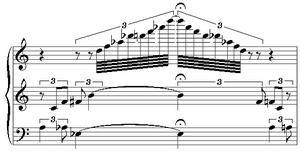Palindrome facts for kids
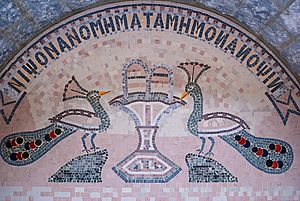
A palindrome is a word, number, phrase, or even a sentence that reads the same forwards and backwards! Think of words like madam or racecar. Even dates and times can be palindromes, like 12/21/33 12:21. A famous sentence palindrome is: "A man, a plan, a canal – Panama".
The longest single word palindrome used often is the Finnish word saippuakivikauppias. It means 'a soapstone vendor' and has 19 letters! In English, the longest is tattarrattat with 12 letters. This word was made up by James Joyce in his book Ulysses to describe a knock on the door.
The word palindrome was first used by an English writer named Henry Peacham in 1638. But the idea of palindromes is much older! People have found examples from the 1st century CE, like the Latin Sator Square. There's also a Greek sentence from the 4th century: nipson anomemata me monan opsin.
Palindromes aren't just in words! You can find them in music, like in special songs called table canons and crab canons. They also appear in nature, especially in our DNA!
Contents
What is a Palindrome?
Where Does the Word Come From?
The word palindrome was first used by the English poet and writer Henry Peacham in 1638. It comes from two old Greek words: πάλιν (palin), which means 'again', and δρóμος (dromos), meaning 'way' or 'direction'. So, it means 'running back again'.
In ancient Greek, they used a different word, καρκινικός (karkinikos), which means 'crab-like'. This was because crabs walk sideways or backwards, just like a palindrome reads the same forwards and backwards!
Palindromes Through History
People have been playing with palindromes for a very long time! An ancient Greek poet named Sotades (who lived around 300 BC) created a type of poetry that some people think was palindromic.
One of the oldest known palindromes was found written on a wall in Pompeii, an ancient Roman city buried by a volcano. This Latin palindrome is called the Sator Square. It says: sator arepo tenet opera rotas. This means 'The sower Arepo holds with effort the wheels'.
What's cool about the Sator Square is that it's also an acrostic. This means if you take the first letter of each word, they spell out the first word. The second letters spell the second word, and so on. You can arrange it into a word square that reads the same forwards, backwards, up, and down!
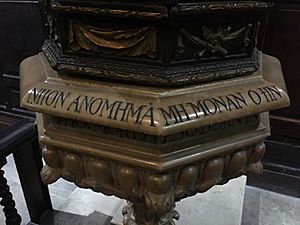
In the Byzantine Empire (an old empire in Eastern Europe), many baptismal fonts (special bowls for baptisms) had a Greek palindrome carved into them. This was from the 4th century and said: ΝΙΨΟΝ ΑΝΟΜΗΜΑΤΑ ΜΗ ΜΟΝΑΝ ΟΨΙΝ. It means 'Wash your sin(s), not only your face'. You can still see this in many old churches today!
In the 12th century, a Hebrew palindrome was created by Abraham ibn Ezra. It was a long sentence about a glutton and honey, and it also worked as a word square.
An old Latin riddle is also a palindrome: "In girum imus nocte et consumimur igni". This means 'we go in a circle at night and are consumed by fire'. It describes moths flying around a flame!
In English, some of the first palindrome sentences were created in the 1600s. One famous early one was by John Taylor in 1614: "Lewd did I live, & evil I did dwel". Later, in 1848, someone made up "Able was I ere I saw Elba". This became very famous because people wrongly thought Napoleon said it when he was exiled to the island of Elba.
Other well-known English palindromes include: "A man, a plan, a canal – Panama" (from 1948), "Madam, I'm Adam" (from 1861), and "Never odd or even" (from 1930).
Different Kinds of Palindromes
Palindromic Characters, Words, or Lines
The most common palindromes are made of characters (letters). This means the letters read the same forwards and backwards. Examples are civic, radar, level, rotor, kayak, madam, and refer. Longer ones include rotator, deified, and racecar.
There are also palindromes where the unit of reversal is the whole word. For example: "Is it crazy how saying sentences backwards creates backwards sentences saying how crazy it is?". Here, each word is reversed in order, but the words themselves stay the same.
Some poems can even be line-unit palindromes. This means the first half of the poem is repeated in reverse order in the second half. But the words within each line stay the same. The clever part is that the second half still makes sense and continues the story!
Palindromic Sentences and Phrases
Many palindromes are full sentences or phrases. For these, we usually ignore punctuation, capital letters, and spaces. Some fun examples are: "Mr. Owl ate my metal worm", "Do geese see God?", or "Was it a car or a cat I saw?".
Some palindromes even work with spaces included, like: "Rats live on no evil star", "Live on time, emit no evil", and "Step on no pets". You can find many more examples in the List of English palindromic phrases.
Palindromic Names
Some people have names that are palindromes! Common first names include Hannah, Ava, Aviva, Anna, Eve, Bob, and Otto. Some last names are also palindromes, like Harrah, Renner, Salas, and Nenonen.
Lon Nol was a Prime Minister of Cambodia whose name is a palindrome. The Japanese writer Nisio Isin uses a pen name that is a palindrome when written in English letters (NisiOisiN). Some people even change their names to be palindromic!
In books and movies, you can find palindromic names too. Stanley Yelnats is the main character in the book and movie Holes. Several Pokémon species have palindromic names like Eevee, Girafarig, and Ho-Oh. The pop band ABBA got its name by using the first letter of each of the four band members' names.
Palindromic Numbers
A palindromic number is a number that reads the same forwards and backwards. For example, 91019 is a palindrome. In fun math puzzles, people look for palindromic numbers with special features. For instance, 191 and 313 are palindromic primes (they are prime numbers and palindromes).
A fun math puzzle is about Lychrel numbers. The question is: if you take a number, reverse its digits, and add it to the original number, will you always eventually get a palindrome? For example, 56 + 65 = 121, which is a palindrome. So 56 is not a Lychrel number. Some numbers, like 196, are thought to never become palindromes this way, but no one has proven it yet!
Palindromic Dates
A date or time can be a palindrome if its digits read the same forwards and backwards. We usually ignore the slashes or hyphens. For example, 11/11/11 11:11 is a palindrome.
A very special palindrome day was 2 February 2020 (02/02/2020). This date was a palindrome no matter how you wrote it (yyyy-mm-dd, dd-mm-yyyy, or mm-dd-yyyy)! Because of this, it was called a "Universal Palindrome Day". Other universal palindrome days include 11/11/1111 and 12/12/2121.
Palindromes in Speech
A phonetic palindrome is a part of speech that sounds the same (or very similar) when said backwards. This is different from how it's spelled. For example, "crew work" and "work crew" sound similar when reversed. Other examples include "dry yard", "easy", and "new moon".
Examples of Palindromes
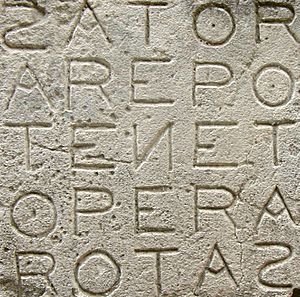
Words
- Mum
- Mom
- Dad
- Deed
- Level
- Pop
- Nun
- Bib
- Wow
- Racecar
- Madam
- Radar
- Malayalam
- Nitin
- Kayak
- Eye
- Tot
- Bob
Sentences
- Was it a cat I saw?
- Do geese see God?
- Rats live on no evil star.
- Never odd or even.
- Madam, I'm Adam.
- Go Hang a salami I'm a lasagna hog
- Top spot
Numbers
- 11
- 121
- 212
- 232
- 353
- 454
- 9009
- 56065
- 121121
Longest Palindromes
The longest single word palindrome listed in the Oxford English Dictionary is tattarrattat. It has 12 letters and was created by James Joyce. The Guinness Book of Records says detartrated (11 letters) is the longest. Another long one is Malayalam (9 letters), which is a language spoken in southern India.
The longest palindromic word used in everyday life is the Finnish word saippuakivikauppias. It has 19 letters and means 'a soapstone vendor'.
Some very long English palindrome sentences have been created. One by mathematician Peter Hilton is "Doc, note: I dissent. A fast never prevents a fatness. I diet on cod". Another by poet Alastair Reid is even longer!
There have even been palindromic novels! Satire: Veritas by David Stephens has 58,795 letters, and Dr Awkward & Olson in Oslo by Lawrence Levine has 31,954 words. The comedian Demetri Martin wrote a 224-word long poem called "Dammit I'm Mad" that is a palindrome. And "Weird Al" Yankovic's song "Bob" is made entirely of palindromes!
Other Places You Find Palindromes
In Classical Music
Some classical music pieces are palindromes. Joseph Haydn's Symphony No. 47 is nicknamed "the Palindrome". In one part, the music plays forwards, and then the exact same music plays backwards!
Composers like Alban Berg and Béla Bartók have also used palindromes in their music. Igor Stravinsky's last piece, The Owl and the Pussy Cat, is a palindrome.
British composer Robert Simpson loved palindromes. The slow parts of his Symphony No. 2 and String Quartet No. 1 are palindromes. His very long String Quartet No. 9 has 32 parts, and all of them are palindromic!
Hin und Zurück ('There and Back') is a short opera by Paul Hindemith. It's a dramatic palindrome! In the first half, a sad story happens. Then, the second half plays the same scenes backwards, with the lines sung in reverse order, to create a happy ending!
In classical music, a crab canon is a special type of song where one part of the melody is played backwards in time and pitch compared to another part.
A table canon is a piece of music printed on a rectangular sheet. Two musicians sit across a table from each other and play it. One musician reads the music upside down compared to the other! The music is written so it sounds good both ways.
In Biological Structures
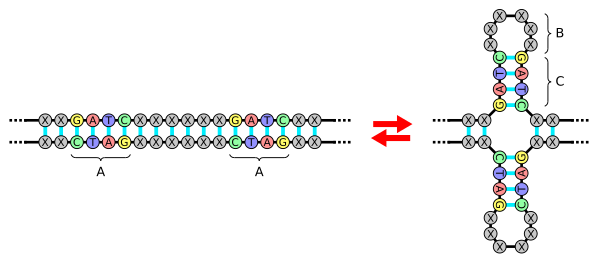
Palindromes are even found in our DNA! DNA is made of two strands that pair up. A DNA sequence is a palindrome if it reads the same backwards on its complementary strand. For example, if one strand is ACCTAGGT, its partner strand is TGGATCCA. If you read TGGATCCA backwards, it's ACCTAGGT!
These palindromic DNA sequences can form special shapes, like a hairpin. Scientists have found many palindromes on the Y chromosome. This palindromic structure helps the Y-chromosome fix itself if it gets damaged. It can bend in the middle and use the other side as a template for repair.
Palindromes are also thought to exist in proteins, which are important building blocks in our bodies. Scientists are still learning what role these palindromes play in how proteins work.
Notable Palindrome Creators
Many people enjoy creating palindromes as a hobby or art form. Here are some famous "palindromists":
- Dmitry Avaliani (1938–2003)
- Howard W. Bergerson (1922–2011)
- Leigh Mercer (1893–1977) – He created the famous palindrome "A man, a plan, a canal: Panama!"
- Georges Perec (1936–1982)
- Mark Saltveit (b. 1961)
- Su Hui (poet) (fourth century CE)
See Also
 In Spanish: Palíndromo para niños
In Spanish: Palíndromo para niños
- Ambigram
- Anagram
- Ananym
- Backmasking
- "Bob" ("Weird Al" Yankovic song)
- Chiasmus
- Constrained writing
- List of English palindromic phrases
- List of palindromic places
- Mirror writing
- Palindromic number
- Pangram



